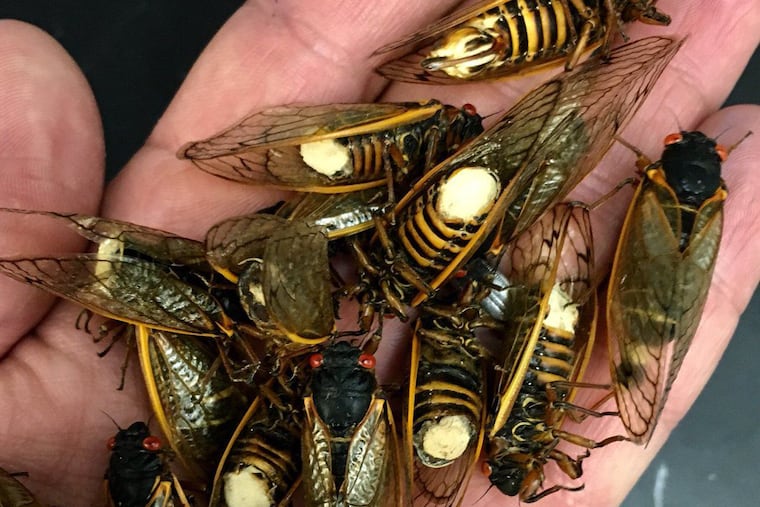‘Zombie’ cicadas, under the influence of a fungus, are mating until death
Sex, drugs, and screaming bugs: for cicadas, zombies are real.

For cicadas, horror stories are real. A mind-controlling fungus, Massospora cicadina, has infiltrated many cicada populations throughout the United States, including Pennsylvania.
Now, scientists have identified some of the chemicals — including psychedelic drugs — that may be behind Massospora’s frightening abilities. Animals infected by the fungi may be the closest thing to real-life zombies, and scientists are beginning to understand how they work.
Zombie stories are everywhere in pop culture, thriving on the fear of losing control. Originally, zombies were depicted as corpses brought back to life via supernatural means. But more recent iterations have searched for scientific causes, yielding still-living “infected” people under the sway of some disease that radically changes their behavior. In the video game franchise The Last of Us, the culprit is a fungus — bringing the zombie concept closer to real life.
Matt Kasson, professor of plant pathology at West Virginia University, doesn’t like to use the term zombie. But he acknowledged the similarity.
“If you think about what the [Massospora] fungus is doing, it is taking over in some regards. ... The [cicada] becomes a vehicle for a greater purpose.”
That purpose? “The fungus just wants the spores spread. It just wants to reproduce," Kasson said.
By the time you see a cicada, it’s too late — the spores have already started growing.
Every summer, cicadas crawl out of the earth, and some encounter Massospora spores lying in wait in the soil.
Annual cicadas are relatively common in the region, emerging every year. Periodic cicadas are rare within the Philadelphia city limits, but can be found in suburban and rural areas. In areas such as Princeton and Franklinville, N.J., massive groups can emerge in certain years, said Jon Gelhaus, curator of entomology at the Academy of Natural Sciences of Drexel University. He was not involved in the study.
After shedding their skin — you may have seen the leftover husks clinging to a tree — cicadas fly about on their new wings and sing loudly. But after a week or two, the fungus makes its presence known.
“Even someone that’s never seen them before would look at them and tell that there’s something wrong with that cicada,” Kasson said. “Over time, [the cicada’s abdomen] sloughs off, revealing more of the fungus underneath. The cicada could be missing up to two-thirds of its body and still be functioning like nothing’s happening." In fact, he said, sometimes the cicada’s activity “is even accelerated.”
The exposed fungus on the cicada’s abdomen releases infectious spores into the air and especially through contact. To that end, Massospora makes cicadas seek out others to mate.
The infection “is sexually transmissible, and spreads to all the cicadas they encounter that way. Males, in addition to trying to mate with females, will also pretend to mate with males ... doubling the number of cicadas [the fungus] comes in contact with,” explained Kasson.
The infected don’t get to reproduce themselves, as they’ve lost the necessary organs to the fungus.
Kasson’s graduate students introduced him to the phenomenon a few years ago. “They brought in the first specimen, and I saw it and said, ‘OK, we have to study this,’" he recalled.
Along with researchers from across the U.S., Kasson has been working to discover the secrets behind how Massospora manipulates its host. By collecting infected cicadas from across the country, the scientists were able to identify 1,176 different chemicals that could be involved. Two, however, stood out because they’re widely known mind-altering compounds.
The team found psilocybin — the key ingredient in “magic mushrooms” — in the species of Massospora that infects periodic cicadas, which emerge every 13 or 17 years.
Massospora in sub cicadas had a different chemical, an amphetamine named cathinone. Cathinone is normally found in the leaves of the khat plant, which are chewed as a stimulant by some people in Africa and the Middle East.
Tatyana Livshultz, assistant curator of botany at the Academy of Natural Sciences, explained that plants and fungi often make chemicals to change insect behavior, but these interactions are usually more benign, such as repelling a would-be herbivore with a bitter taste or attracting a pollinator to a flower with a sweet smell. Livshultz, who was not involved in the study, points out that exactly how cathinone and psilocybin affect cicadas is still unknown; the study merely found the compounds. It did not establish their precise function.
While Kasson suspects that these chemicals help Massospora take control, he didn’t test their effects because he was concerned about running afoul of federal regulation of controlled substances.
“I had to report all of [my research] to the [Drug Enforcement Agency] because I was afraid they were going to come in and confiscate my cicadas, Tase me, and throw me in jail," Kasson said wryly. He is planning to apply for DEA clearances for future experiments.
There is no need to fear Massospora creating human zombies. The fungus has evolved for millions of years to specialize on cicadas, so infecting an entirely different animal is not an option. “You go down that road evolutionarily, you are putting all those eggs in one basket. That limits a lot about the parasite," Gelhaus explained.
And coming into contact with infected cicadas is extremely unlikely to give you a buzz, Kasson said. The chemicals are found in such tiny amounts, a person would have to ingest a horrifying number of them to feel anything other than revulsion at eating moldy cicadas.
It is likely, however, that nature will continue to provide material for horror fiction. As Livshultz puts it: "We are still just scratching the surface.... We still live in a largely undiscovered world. It’s fascinating, thrilling to see what’s out there and imagine what else could be.”